Latest update 14 April 2006
Message 4791 Jul 4, 2004
Hi HUD, As can be seen from the drawing it is for a mask mounted mini regulator. The high
pressure hose was held in place by a small clip on the helmet. Later the regulator was
moved down between an ordinary oxygen hose and the high pressure hose as we have seen so
often. I am not sure why the change, but it might have been awkward to have the fairly
stiff oxygen hose routed back over the shoulder. My guess is that it would not take much
manoeuvering and head movements before the hose was pulled free from the clip with the
risk of getting entangled in the cockpit.
Cheers, Bluelight
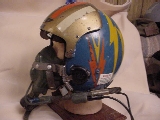
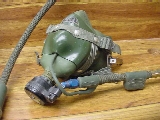


high pressure oxygen hose is routed backwards and held to the helmet by an clamp. A warning sticker on the hel-
met explains how to route the hose. Pictures © Milehigh
Message 4788, Jul 4, 2004
On this auction by Steve Hester, there is a very strange Redar setup for the APH-5. Never
seen it before.
http://cgi.ebay.com/ws/eBayISAPI.dll?ViewItem&category=135&item=2254934556&rd=1
Bye HUD
Message 405, Jan 11, 2004
Hi all, eBay seller 'airforce1944' has just given his permission that we can use his
pictures here in the flyingclothing group and on the Best of Flightgear website. I hasten
to upload the pics of the orange APH-5 with Leopard artwork to the APH-5 page.
Cheers, Bluelight

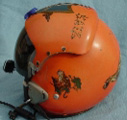
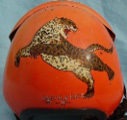
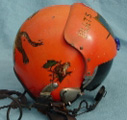
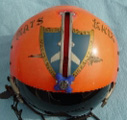
APH-5 helmet with custom artwork flown by Capt. Marvin
A. Catz, USN. Click on the pictures to see
them in larger size. © airforce1944
Message 3351, Jul 5, 2001
The attached article was kindly provided by one of our museum-associated members who
thoughtfully dug it out of his archives and shared it with me. Since it contains important
background information on the subject of the US Navy's introduction of the "new"
APH-5 helmet, back in 1956, I attempted to do an OCR scan of the article with the idea of
making it available to the forum members as an attachment. The OMNI-OCR program did a fair
job of it and the result is attached in MS/WORD 2000 (.DOC) format. Any unintelligible
errors are probably my fault and not that of the author of this article, which originally
appeared in the Navy's APPROACH MAGAZINE for January 1957.
Several interesting points are brought out in this article. One is that the Navy's
post-war Cornell University head protection studies were the foundation of many of the
following generation improvements in American flightgear head protection design. These
studies compared the US Navy's H-1 helmet and the US Air Force's P-1 designs alongside
other designs that even included standard US football style sports team protection
helmets, in an effort to develop definitive criteria on the best way of achieving adequate
head and cervical spine protection, without adding excessive weight. Second is that the
Navy's APH-5 was a close relative of the MSA model N2 prototype, which was apparently
manufactured in limited quantities (keep you eyes open for one of these, which surely must
be among the rarest of the rare!). Further, the original APH-5 helmet was designed without
a visor, which necessitated additional work so as to allow the added visor to be
compatible with the Navy's Martin-Baker type head-curtain actuated ejection seats
(anti-fouling). Finally, the APH-5 initially used a right side com-cord connector, very
much in the style of the US Air Force's helmets, but after it was found to be subject to
damage, the com cord was reconfigured to exit at the rear of the helmet, inside the edge
of the shell. Interesting reference is made to the subject of some experimental studies
known as the "BBC-X2" helmet in this article and mention is also made of the
Hardman "Christmas-tree" style bayonet mask suspension system (proving that it
was in limited use on the first APH-5s as early as 1957). One of the other interesting
points made in this article is a brief comparison between the US Air Force's P-series
helmets and the new APH-5 design.
The US Air Force's HGU-2/P design, as has been shown, was simply a slightly reworked APH-5
helmet which had been modified to reflect US Air Force preferences in terms of various
features (such as mic-connector, chin-strap, helmet mask attachment, and liner pads,
etc.).
Thanks to our member who shared this article with me; I hope that you all find it of equal
interest, since so many subsequent developments stemmed directly from the original US Navy
research studies (and the MSA "N2") that resulted in the APH-5 helmet of
1956-57.
Cheers, DocBoink
APH-5 article
Message 1499:
Hello All, I have that information on the APH-5 [Message 1442]. The article was
in the June 1956 issue of "Naval Aviation News", page 35. It announces the
introduction of the APH-5, stating that the distribution began in April of 1956. Also in
an "Approach" article (October 1957, p.32) states that 10,000 hemets had been
delivered by Feb of 1957, It talks about some design changes that may delay the 1958
delivery schedule. The references are: ACSEB 3-57, 5-57, and 13-57. Does anyone have or
know where copies of these might be obtained?
The photo of the APH-5 in the June 1956 article shows that the helmet originally had
leather Ox mask tabs, and they show the MS22001 with the yoke fastening. Bones
Message 1497:
I have noticed a trend on E-Bay and it may have something to do with the distribution of
US flight equipment. I am just thinking out loud and welcome any comments.
I would say that during the cold war, a substantial number of USAF aircraft may well
have been deployed in Europe. I noticed early on when dealing with European collectors
that they had quite an array of USAF flight gear, but were not as well stocked on US Navy
equipment. In fact, I made quite a few trades of Navy equipment for International
equipment. It would seem that the "demand" for US Navy equipment has created a
sort of conversion process for sellers on E-Bay. What was a USAF helmet can be cleaned up
and marketed as a US Navy helmet to fetch a higher price.
One of the things that is disturbing to me is the very high premium some collectors are
willing to pay for "decorated" helmets. Especially when the helmet has a nice
fresh coat of paint and shows no sign of wear. Coupled with the confusion over USAF vs US
Navy helmets, it would seem there are a lot of cross over items that are simply not
authentic. I am interested in hearing the opinions of others as regards to the paint
jobs and decorations that adorn some of these flight helmets and also would like to hear
from others on the US Navy Vs USAF helmets.
The USAF life support guys told me they didn't use Navy helmets AT ALL. Perhaps because
the helmets are all cut from about the same mold, literally. To put this in perspective:
The APH-5 and HGU-2 are the same helmet shell. The HGU-22/P is the same shell as the
HGU-2 which is the basis for the HGU-26/P.
This next part is probably going to get me in a jam, but here goes anyway. The USAF tried
to cut the HGU-22/P shell back at the 3, 9 and 12 o'clock position to increase visability.
It was discovered that these cuts waekened the shell .So the USAF jumped on the HGU-33/P
shell (PRK-37/P) for the HGU-48/P which was the basis for the HGU-55/P.
That means there are basically 2 helmet shells for most of the USAF/USN helmets and would
mean that cross use between services is unecessary. Even the APH-6 is the early
shell with o-mask cut outs.
For the record, I have a report on the HGU-48/P that verifies the use of the HGU-33/P
shell. This should also explain why the Navy could transition with little effort to the
HGU-55/P. Cause the -33 is a -55 with a visor assembly....
Now you may talk amongst yourselves. For the record, my parents were married. Cheers,
Steve N
Message 1442:
Hello All, I have the copy of the "Approach" article, and will be glad to share
it, however I need to have a somewhat warm day to go get it. I also have a 1961 dated
HGU-2/P, I can photograph this nxt to the APH-5 for comparison. A few years ago, I went
through all the issues of "Naval Aviation News" and "Approach" (plus
the AF mags as well) for articles on flight gear. Thanks to Rich Mays I still have them. I
brought them in from my shop and collection building, just before the fire, so they did
not burn, and I can share them. Best wishes Bones (Bill Cook)
Message 1430
Not a "tired" old subject at all. The APH-5 to HGU-2/P story is always
interesting. I'd love to hear more about the specific APPROACH citation you referenced.
Better still, if someone was able to obtain a copy and make it available to all of us, eh?
Perhaps the USN Aviation Museum in Pensacola could dig out a copy of that issue, if no one
has one handy? Cheers, DocBoink
Message 1429:
Greetings all I kind of hate to dredge up this old topic, but I have not been around. The
APH-5 was actually introduced into the Navy in 1956, there is an article in
"Approach" magazine announcing the introduction for fighter aircraft first. I
copied the article so I will try to get the exact citation. Bill
Message 929:
That confirms my long-held suspicions that it was a USN development that the USAF adopted.
This would also explain a few VERY early USAF HGU-2/P helmets that appear to be all but an
exact copy of the APH-5 except for the USAF star and wings (see one in particular that
appears in the Wise and Breuninger book--it also has a "stepped round visor
knob"). I am sure that before the USAF had standardized their own specific version of
the helmet, one or two Navy APH-5s were "worked up" as prototype HGU-2/P
helmets--hence the confusion over those oddball "early" HGU-2/Ps. Cheers,
DocBoink
Message 917:
Hi everyone. Though I'd share a couple of blurbs from a recently acquired technical report
from Gentex. Author of the document is one Aleander A. Kozuch and he is listed as the
manager of the model shop. The Report is titled 'Evolution of the Helmet ( P Series)
Shell". Of particular interest is the following lines, verbatum from the report: At
this time, a new helmet was being developed by the Navy and put into the system in the
early 1960s which Army Q.M and the Air Force adopted along with the Navy for their
aircraft. A track visor and housing assembly was also developed for the helmet. The Navy
called this an APH-5, the Air Force called it an HGU-2/P. This sort of cinches the common
roots of these helmets and may put to rest the "which came first" and
"which one is based on which" issues. Thought everyone would enjoy this. Cheers,
Steve N.